Abstract
Objectives:
Breast cancer patients suffer from madarosis (loss of eyelashes) due to chemotherapy side effects. An effective treatment or prevention for alopecia or madarosis induced by chemotherapy is not available. Potential drug side effects of bimatoprost solution include increased eyelash length, darkness, and number. A formulation of bimatoprost which maximizes eyelash enhancement and minimizes intraocular and systemic side effects has not been reported.
Materials and Methods:
An Institutional Review Board (IRB) and Investigational New Drug (IND) approved, randomized, single-blinded, prospective, internally controlled trial compared bimatoprost eyelash gel in relation to eyelash enhancement of madarosis patients. Forty eyelids of 20 chemotherapy-treated breast cancer patients were randomized to treatment or control (fellow eyelid). Both patient and surgeon (blindly) evaluated bimatoprost gel's effectiveness in improving eyelash appearance at baseline and at monthly intervals.
Results:
The median follow-up time was 3 months (range 1-4). There was a significant difference between treated and fellow eyelash length during month 2 [1.00 mm (P=0.004)] and month 3 [1.00 mm, P=0.02)], in eyelash pigment [month 1 (2.5, P=0.04); month 2 (2, P=0.0009); month 3 (3, P=0.06)] and thickness [month 2 (2, P=0.002); month 3 (3, P=0.01)]. There was an improvement in the patient satisfaction scale from baseline 16 (median, range 7-21) to 26 (median, range 17-33, P=0.002) at last follow-up.
Conclusions:
Bimatoprost eyelash gel appears promising for chemotherapy-induced madarosis. Patients may find the effects restorative and cosmetically enhancing.
Keywords: Bimatoprost, chemotherapy, eyelash, hypotrichosis, madarosis
INTRODUCTION
Since there have been major advancements in the battle against breast cancer, patient survival has improved. Consequently, the clinician is now faced with the challenges of managing and improving the cancer patient's quality of life, including the chemotherapy-related sequelae. One of the psychologically and emotionally challenging sequelae is madarosis or hypotrichosis (loss of eyelashes). This condition can place the patient at risk of corneal injury and decreased vision due to the protective mechanism of the cilia of the eyelids (eyelashes). Use of synthetic eyelashes can be frustrating to patients due to poor adherence and esthetic appearance. While eyelash grafts have been used, less invasive alternatives are needed.
While alopecia of the scalp can be successfully camouflaged with wigs and scarves, the lack of eyelashes is not as easy to conceal. Patients often complain that the loss of eyelashes and subsequent inability to wear mascara makes them look more fatigued. More importantly, the eyelashes serve to protect the eye. Thus, measures to encourage eyelash growth can preserve vision and be esthetically pleasing. Despite all the efforts made, researchers have yet been able to identify an effective topical treatment for prevention for alopecia or madarosis induced by chemotherapy.
It has been documented that increased eyelash growth is a side effect of the drug, bimatoprost.[1–5] While the same formulation of 0.3% bimatoprost was United States (US) food and drug administration (FDA) approved in 2009, for the cosmetic use in patients with hypotrichosis (Latisse®), no studies using this formulation or any others have been done in regards to chemotherapy-induced madarosis. The creation of a gel preparation rather than the standard solution was intended to allow a more precise application to the eyelash follicle with less chance of entering the eye. Thus, the formulation would lessen ocular and periocular side effects and target the eyelash follicle better.
The goal of this study was to assess bimatoprost gel's effects on eyelash growth, amount, pigment, and thickness in the setting of madarosis induced by chemotherapy. Complications and adverse effects were recorded and evaluated.
MATERIALS AND METHODS
This was an Institutional Review Board (IRB) and Investigational New Drug (IND) approved, randomized, single-blinded, prospective, internally controlled trial. It evaluated the ability of bimatoprost eyelash gel to improve madarosis in breast cancer patients receiving chemotherapy. The adverse effects of the product were examined. Both a blinded oculoplastic surgeon and the patient rated the ability of the product to enhance eyelashes.
Twenty patients were enrolled in the study for an anticipated total of 20 treated eyelids and 20 non-treated eyelids. Eligible patients were those between the ages of 25 and 80 years, suffering from breast cancer chemotherapy-induced madarosis (eyelash loss). Ten patients were currently undergoing chemotherapy at the time of enrollment and 10 patients had more than a 6-month chemotherapy-free interval. All patients had madarosis and/or hypotrichosis at the time of enrollment. Eligible patients were initially identified by the Duke Oncology Department and referred to the Department of Ophthalmology, Oculoplastic Service, for further management and care. Informed written consent was obtained from all the patients. All aspects of the study complied with Health Insurance Portability and Accountability Act (HIPAA) guidelines. The clinical trial was formally registered at www.clinicaltrials.gov.
Randomization
A separate file assigning patient numbers and treated eyelid (10 right eyelids, 10 left eyelids) was created. Twenty envelopes, numbered 1-20, were filled with either right or left eyelid labels. This information was recorded and kept in a secure area inaccessible to the primary investigator (PI). The sealed envelopes were randomly distributed to patients. Patients were not allowed to reveal treated eyelid to the surgeon (PI). Each study participant applied the product to eyelashes of one eyelid as directed by the surgeon and product instructions, leaving the fellow eyelid and eyelashes as an internal control, creating a treatment and control group, respectively.
All study participants received an ophthalmic exam at each visit. Clinical photographs of both the treated and control eyelids were taken at baseline and at monthly clinical examination intervals thereafter. All photographs were taken makeup-free. The patients were instructed to apply the gel only to the upper eyelash margin with a fingertip or cotton swab upon awakening in the morning.
Following initial application of the product, both the surgeon and patient assessed the efficacy of the product on a monthly basis. Patients were asked to report compliance with daily applications of the products and any adverse effects related to the use of the product. Using digital photographs, a blinded surgeon graded the eyelash appearance based upon: Length (millimeters) as measured with an eyelash ruler (specifically bioengineered to contour the eyelid), number (absolute amount), pigmentation (scale of 1-5, 5 being the darkest), and thickness (scale of 1-5, 5 being the thickest). The eyelash length was measured using a bioengineered ruler in 1 mm increments contoured to the eyelid. During evaluation of eyelash pigment and thickness, the baseline photograph and the photograph of the fellow eye were used as the comparison photograph. The reviewers were not aware which picture corresponded to baseline, control, or treatment eyelashes. The blinded reader's assessment of the eyelash[1] parameters was recorded at each study visit for each eyelid.
The patient's assessment was obtained by an objective monthly questionnaire, Eyelash assessment rating scale (EARS), derived by the author (Carrie Morris). Patients were asked to rate the treated eyelash length, thickness, amount, darkness, durability, contour, and overall appearance at each follow-up visit using a numerical rating scale (1-35, each weighted 5 points, 35 being the highest score). The patients were followed for 3 months.
Drug preparation
Bimatoprost was made into a gel form by the study investigators. The drug used in this study is an investigational new drug and not approved by the FDA. However, an investigational new drug (IND) research permit was obtained for this study drug. It is made from bimatoprost, which is an FDA approved eye drop for glaucoma. The eyelash gel was compounded at Duke Compounding pharmacy by the author (Carrie Morris) under the supervision of Ken Latta, the Director of compounding pharmacy at Duke University Medical Center (DUMC).
Data collected underwent statistical analysis using testing recommended by our departmental statistician to detect if a difference exists and to what degree between the treated eyelashes and non-treated eyelashes based on the parameters discussed above. The four primary outcomes of the study include: 1) incremental increase in eyelash length (millimeters) and 2) number and 3) qualitative improvement in eyelash thickness and 4) pigment. Each variable was assessed at baseline and at each monthly time point. A secondary outcome was the EARS patient rating score of eyelash enhancement at each time point.
For each patient, the difference from baseline to 3 months (or last follow-up visit) in eyelash length was computed for each eye. Then, the difference between eyes with respect to change from baseline was computed and tested for equality to zero using the paired t-test (or Wilcoxon signed rank test). This comparison is the difference between treatments and is the primary outcome of the study. Similar assessments were carried out for eyelash length, thickness, pigment, and quantity at additional time points using a paired t-test or Wilcoxon signed rank test.
For continuous variables (age, duration of follow-up), means, standard deviations, median, minima, and maxima were computed. For categorical variables (sex, race, complications), frequencies and percentages were obtained. Other variables, such as past medical history or surgeries, were summarized.
RESULTS
All 20 female patients enrolled [Caucasians (18), African Americans (2)] had a median age of 50 years (range 31-66). Eighteen patients returned for follow-up [Table 1]. The median follow-up time was 3 months (1-4). Ten patients were currently undergoing chemotherapy and 10 patients had a median of 6 months (1-48) chemotherapy-free interval. Importantly, no difference was noted for any parameter between those who were currently undergoing chemotherapy and those who had a chemotherapy-free interval [Table 2].
Table 1.
Patients’ demographics are listed including percentages of patients undergoing chemotherapy during the trial, current and previous treatment with radiation, tumor stage, and Fitzpatrick skin score
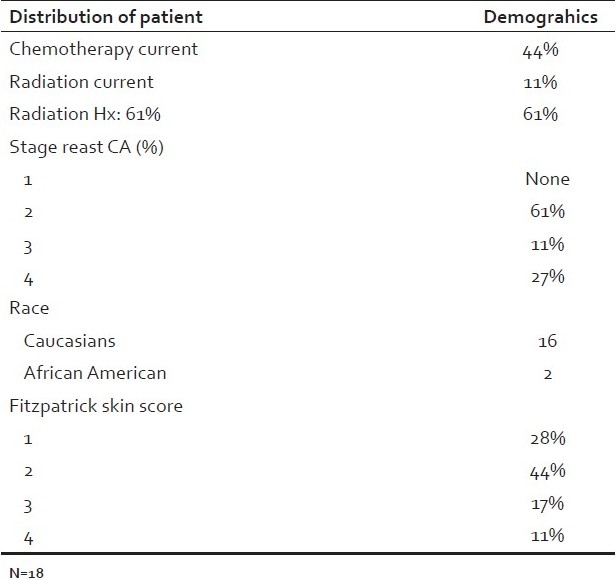
Table 2.
Chemotherapy
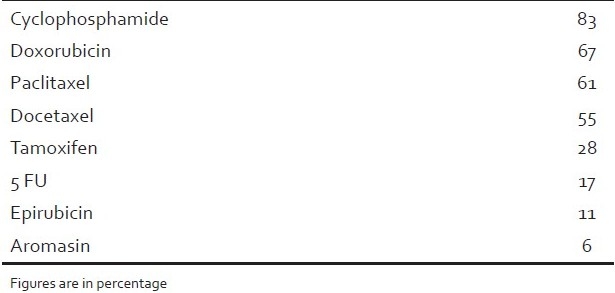
Length
There was a statistical difference in median length at months 2 and 3 between treated and fellow eyelid [1 mm (range -0.5 to 2), P=0.004 and 1 mm (range -1 to 4.5), P=0.02, respectively] [Table 3]. The median change in length of lashes from baseline to 3-month visit was 1.50 mm (range -0.50 to 3.00, P=0.001) for the treated eye versus 0.46 mm (range -2.0 to 2.5, P=0.02) for the control eye. Importantly, there was no difference in eyelash length at baseline [Table 3, Figures 1a and 2a]. There was a statistical difference in change from baseline of the treated eyelid versus the fellow eyelid at months 2-3. There was no difference in response to eyelash gel due to current versus previous chemotherapy. There were no correlations among the other parameters analyzed in regards to eyelash length.
Table 3.
Comparison of eyelash length using bimatoprost gel and control

Figure 1.

Graphs indicate changes in (a) eyelash length, (b) amount, (c) pigment, and (d) thickness over 3 months treatment. Differences in treated eyelid versus fellow eyelid are shown with statistically significantly P values between treated and fellow eyelid
Figure 2.
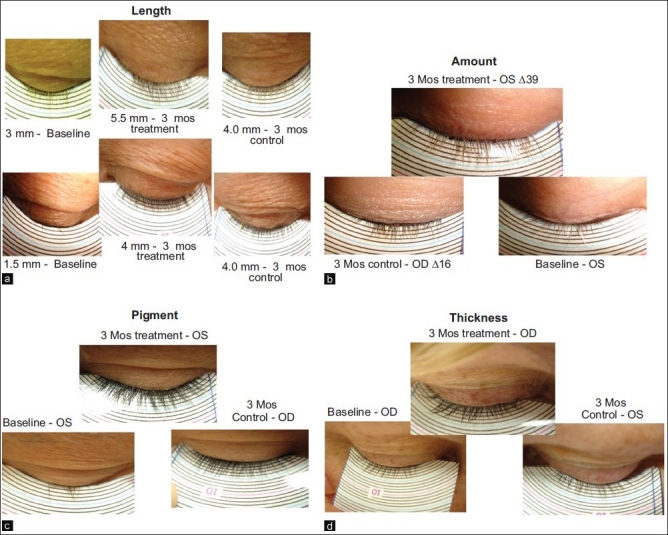
Digital eyelash ruler illustrates differences in eyelash length (a) length, (b) amount, (c) pigment, and (d) thickness compared to baseline and control eyelid at 3 months
Amount
The number of lashes was noted to be significantly increased in both the treated and control eyelids compared to baseline at months 1-3 in both the treated eyelids. Yet, there was no difference found between the treated and fellow eyelashes at any time point. However, there was a trend of more numerous eyelashes in the treated eyelid at month 3 [Table 4, Figures 1b and 2b].
Table 4.
Comparison of eyelash number using bimatoprost gel and control

Pigmentation
Notably, more eyelash pigmentation occurred in treated eyelids during months 1 and 2 [median 2.5 (range 1-4), P=0.04 and median 2 (range 1-5), P=0.009, respectively) compared to the fellow eyelid [Table 5]. There was a trend of more pigmentation of the treated eyelid at month 3. A significantly greater change from baseline in comparison to the fellow eyelash occurred at months 1-3 in the treated eyelid [Table 5, Figures 1c and 2c].
Table 5.
Comparison of eyelash pigment using bimatoprost gel and control

Thickness
Of note, treated eyelashes were thicker than fellow eyelashes during months 2-3 [median 2 (range 1-4), P=0.002 and median 3 (range 2-5), P=0.04, respectively]. Treated eyelids were significantly thicker compared to baseline during months 1-3, while the fellow eyelids did not show a notable change from baseline [Table 6, Figures 1d and 2d].
Table 6.
Comparison of eyelash thickness using bimatoprost gel and control

Patient satisfaction
There was a median improvement of the Eyelash Assessment Rating Score (EARS) patient satisfaction scale from baseline 16 (median, range 7-21) to 26 (median, range 17-33) at last follow-up visit. A notable improvement in satisfaction occurred at every monthly interval compared to baseline [(P=0.007), month 1; (P=0.0002), month 2; (P=0.002), month 3]) [Table 7].
Table 7.
Patient assessment of efficacy of bimatoprost eyelash gel
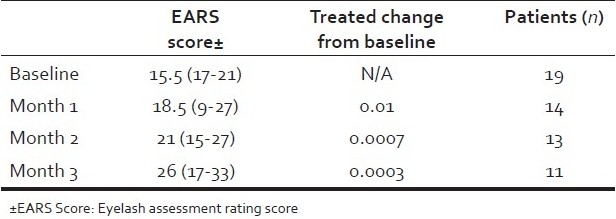
Correlations
The various parameters like age, eye, race, type of chemotherapy, radiation history, current versus history of chemotherapy, hormone receptor status, tumor stage, and Fitzpatrick skin score were analyzed for univariate and multivariate correlations in regards to eyelash length, amount, pigment, thickness, and EARS score. Yet, no correlations were found among any of the variables analyzed.
Side effects
There was one case of periocular hyperpigmentation/hypertrichosis. No change in vision or intraocular pressure occurred between treated and control eye. There were no episodes of conjunctivitis, ocular irritation, conjunctival hyperemia, uveitis, iris heterochromia, or cystoid macular degeneration. Two patients withdrew from the study unrelated to the eyelash gel [Figure 3].
Figure 3.
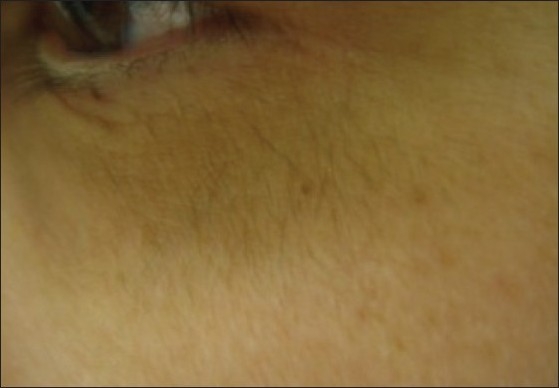
Treatment of the eyelashes also resulted in periocular malar pigmentation. The patient liked the results on her eyelashes so much that she wishes to continue using the gel despite the minimal side effect. There were no occurrences of macular edema, uveitis, intraocular pressure change, or vision decrease or loss
DISCUSSION
Effectiveness
According to our results, the bimatoprost eyelash gel caused the treated eyelashes to increase in length, pigment, and thickness. Despite the fact that statistically there was a trend related to an increase in eyelash amount in the treated eyelashes, clinically we observed a notable difference in eyelash number of the treated eyelid. We attribute this discrepancy to the possibility of measurement error, since it was difficult to count each eyelash when they were overlapping and abundant. As patients used the gel over the course of the study, they became increasingly pleased with its overall results. The fact that no instances of conjunctival hyperemia or ocular irritation as well as more serious potential side effects occurred may be due to the change in formulation to a gel rather than a solution.
Initial clinical evidence of prostaglandins’ effects on eyelashes was discussed by Johnstone[5] who reported that in 19.5% of patients (n=43) treated for unilateral primary open angle glaucoma, increased the length of the lower eyelashes. Two patients experienced an increase in the number, thickness, and curvature with treatment. While multiple reports of antihypertensive prostaglandin solutions inducing lengthening and darkening of lashes are in the literature[6–10], no investigations regarding a direct application or gel formulation have been published. While there are some non-FDA approved formulations that have been detected to contain bimatoprost (RevitaLash, and Age Intervention Eyelash by Jan Marini, etc.),[11] the concentration and vehicle are not known and have not undergone formal scientific evaluation. Without proper administration and management by an ophthalmologist, over-the-counter availability could place the patient at risk for low, but possible side effects.
Gel versus solution
One of the distinguishing factors in our study was the creation of a gel formulation using the standard 0.03% bimatoprost solution, which is an antihypertensive used to treat glaucoma. Recently, the release of Latisse by Allergan, the manufacturer of Lumigan® (bimatoprost), has repackaged the same concentration of bimatoprost solution with a brush to administer the medication to the eyelashes instead. We created a gel several years prior to its release in the market and obtained an IND due to the new formulation. While there have not been head-to-head comparative studies of the gel versus the bimatoprost solution at this time, theoretically we believe that a gel is a superior delivery vehicle to the eyelash follicle. Importantly, there is less chance of intraocular delivery with the gel form, which minimizes side effects. Side effects of bimatoprost solution include conjunctival hyperemia (20%), herpes simplex virus keratitis, permanent iris hyperpigmentation, iris pigment epithelial cyst, uveitis, cystoid macular edema, and periocular hyperpigmentation and hypertri-chosis.[12,13] Also, use of topical bimatoprost more than once daily can result in an increase in intraocular pressure and, potentially, glaucoma. There is one case report of a choroidal detachment secondary to hypotony caused by the use of bimatoprost solution.[14] While some of these side effects were not noted in the original Allergan supported study for Latisse, only two ophthalmologists were involved in the study and the remainder of the physicians were dermatologists. Five out of six of the physician investigators are reported paid consultants and/or stockholders of Allergan, Inc. Side effects may not have been noticed by the non-ophthalmologist. Therefore, it is important that an ophthalmologist be involved in the distribution and monitoring of this medication to ensure patient safety, which is now being marketed for cosmetic purposes. We advocate the use of a gel when treating eyelash hypotrichosis to lessen the chance of possible ocular side effects.
Side effects
Hyperemia
In comparison to the side-effect profile of a large, 6-month study of 133 patients which evaluated bimatoprost ophthalmic drops (Lumigan),[15] our study had a better safety profile. There were no occurrences of conjunctiva or eyelid hyperemia or irritation, while Noecker's study reported conjunctival hyperemia (44%), reported pruritis (9.8%), and ocular burning (5.3%).[4,12] It is to be noted that Noecker's study analyzed side effects of topically applied bimatoprost solution to the eye, which is an FDA approved use. Our study, using the gel formulation, caused less irritation than Lumigan.[1] We believe that this is likely due to difference in location of application (eyelash vs. eye) and mode of delivery (gel versus solution).
Hyperpigmentation
In regards to possible hyperpigmentation that has been associated with bimatoprost,[1,3,16] a recent retrospective review of 37 patients found that if periocular skin hyperpigmentation occurs, it completely resolves upon discontinuation of the drug usually within 6-14 months.[1–3] Our patient who experienced lateral malar hyperpigmentation of the treated eyelid wished to continue treatment because of pleasing results achieved regarding eyelash appearance in terms of improved eyelash length, number, thickness, and greater pigmentation. Treatment and preventative options for malar hyperpigmentation include epilation and/or using concealer and gauze pads underneath the lower eyelid as a barrier.[17]
Limitations
We recognize that our findings are limited by a small sample size and limited follow-up time. The rating scales of eyelash pigment and thickness by the surgeon and the EARS score, which was determined by the study participant, incorporate an inherent amount of subjective error. It is also difficult to account for every eyelash due to the overlapping arrangement when they are numerous. This circumstance allows for additional measurement error. Use of a phototrichogram may give a more accurate measure in the future. However, the length and amount parameters are quantitative values offering a better scientific assessment of the efficacy of the eyelash gel. Since this was a self-administered treatment, compliance also impacted the outcome parameters. However, due to their severe degree of madarosis and hypotrichosis, the study population was likely more motivated than healthy individuals who only seek cosmetic enhancement rather than functional repair. We hoped to maximize the validity of this study by its prospective nature, which used internally controlled randomly assigned participants and a blinded surgeon to grade the eyelash photographs. The study was designed to assess the impact of the timing of chemotherapy in regards to the patients’ response to bimatoprost eyelash gel. We did not observe any difference between patients who were currently receiving chemotherapy and those that had a chemotherapy-free interval of greater than 6 months. Moreover, no differences were found among specific chemotherapy drugs and degree of response. However, at a tertiary care facility, many patients are on experimental protocols with many variations of treatment. So, a correlation would be difficult to detect given the small sample size.
SUMMARY
Bimatoprost eyelash gel increased eyelash length in the treated eyelids. There was a trend for increase in the rate of eyelash growth in comparison to control eyelids. There was a significant increase in the number of eyelashes in both treatment and fellow eyelids overtime. There was a notable difference in the eyelash pigment of treated eyelashes compared to fellow eyelashes at months 1 and 2. Eyelash thickness was significantly greater at months 2-3 in treated eyelashes versus control eyelid.
Patients were pleased with the results achieved by bimatoprost eyelash gel, including the minimal side effects observed. A role of both functional and cosmetic benefits may be achieved with use of bimatoprost eyelash gel. Further investigation with a multicenter, blinded, randomized, controlled trial is needed to explore the long-term results.
Footnotes
Source of Support: Nil
Conflict of Interest: None declared.
REFERENCES
- 1.Tosti A, Pazzaglia M, Voudouris S. Hypertrichosis of the eyelashes caused by bimatoprost. J Am Acad Dermatol. 2004:S149–50. doi: 10.1016/j.jaad.2004.05.002. [DOI] [PubMed] [Google Scholar]
- 2.Namazi MR. Prostaglandin analogs for hair growth: Greater expectations. Dermatol Online J. 2003;9:29. [PubMed] [Google Scholar]
- 3.Galloway GD, Eke T, Broadway DC. Periocular Cutaneous Pigmentary Changes Associated with Bimatoprost Use. Arch Ophthalmol. 2005;123:1609–10. doi: 10.1001/archopht.123.11.1609. [DOI] [PubMed] [Google Scholar]
- 4.Kapur R. Bimatoprost-induced periocular skin pigmentation. Arch Ophthalmol. 2005;123:1541–6. doi: 10.1001/archopht.123.11.1541. [DOI] [PubMed] [Google Scholar]
- 5.Johnstone MA, Albert DM. Prostaglandin-induced hair growth. Surv Ophthalmoly. 2002;47:S185–201. doi: 10.1016/s0039-6257(02)00307-7. [DOI] [PubMed] [Google Scholar]
- 6.Wolf R, Matz H, Zalish M, Pollack A, Orion E. Prostaglandin analogs for hair growth: Great expectations. Dermatol Online J. 2003;9:1–7. [PubMed] [Google Scholar]
- 7.Mansberger S, Coiffi G. Eyelash formation secondary to latanaprost treatment in a patient with alopecia. Arch Ophthalmol. 2000;118:718–9. doi: 10.1001/archopht.118.5.718. [DOI] [PubMed] [Google Scholar]
- 8.Kawano M, Komi-Kuramochi A, Asada M, Suzuki M, Oki J, Jiang J, et al. Comprehensive analysis of FGF and FGFR expression in skin: FGF18 is highly expressed in hair follicles and capable of inducing anagen from telogen stage hair follicles. J Invest Dermatol. 2005;124:877–85. doi: 10.1111/j.0022-202X.2005.23693.x. [DOI] [PubMed] [Google Scholar]
- 9.Saski S, Hozumi Y, Kondo S. Influence of prostaglandin F2alpha and its analogues on hair regrowth and follicular melanogenesis in a murine model. Exp Dermatol. 2005;14:323–8. doi: 10.1111/j.0906-6705.2005.00270.x. [DOI] [PubMed] [Google Scholar]
- 10.Tran D, Sinclair RD, Schwarer AP, Chow CW. Permanent alopecia following chemotherapy and bone marrow transplantation. Australas J Dermatol. 2000;41:106–8. doi: 10.1046/j.1440-0960.2000.00405.x. [DOI] [PubMed] [Google Scholar]
- 11.Age Intervention Eyelash. [Last cited on 2007 Nov 11]. Available from: www.fda.gov/safety/medwatch/safety information .
- 12.Hart J, Shafranov G. Hypertrichosis of vellus hairs of the malar region after unilateral treatment with bimatoprost. Am J Ophthalmol. 2004;137:756–7. doi: 10.1016/j.ajo.2003.09.002. [DOI] [PubMed] [Google Scholar]
- 13.Zimmerman TJ, Hahn SR, Gelb L, Tan H, Kim EE. The impact of ocular adverse effects in patients treated with topical prostaglandin analogs: Changes in prescription patterns and patient persistence. J Ocul Pharmacol Ther. 2009;25:145–52. doi: 10.1089/jop.2008.0072. [DOI] [PubMed] [Google Scholar]
- 14.Pathanapitoon K, Kunavisarut P. Choroidal detachment after topical prostaglandin analogs: Case report. J Med Assoc Thai. 2005;88:1134–6. [PubMed] [Google Scholar]
- 15.Noecker R, Bulau S, Schwiegerling J. Xalatan-induced changes in periocular skin pigmentation and lash dimensions measured using a digital imaging technique. Invest Ophthalmol. 1999;40:S832. [Google Scholar]
- 16.Hart J, Sharanov G. Hypertrichosis of vellus hairs of the malar region after unilateral treatment with bimatoprost. Am J Ophthalmol. 2004;137:756–7. doi: 10.1016/j.ajo.2003.09.002. [DOI] [PubMed] [Google Scholar]
- 17.Centofani M, Oddone F, Chimenti S, Tanga L, Citarella L, Manni G. Prevention of dermatologic side effects of bimatoprost 0.03% topical therapy. Am J Ophthalmol. 2006;142:1059–60. doi: 10.1016/j.ajo.2006.07.019. [DOI] [PubMed] [Google Scholar]


